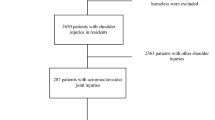Abstract
Purpose
The purpose of this study was to investigate the association between acromioclavicular (AC) joint pain and superior capsular bulging assessed by ultrasound in adolescent baseball players.
Methods
One hundred and fifty players (1st–8th graders) were examined. All subjects underwent physical examinations, including assessment of tenderness on the AC joint and provocative tests (the Buchberger’s test and the cross-body adduction stress test). Bilateral AC joints with the arm in both the resting and the cross-body positions were examined by ultrasound.
Results
Twelve of 150 players (8 %) had AC symptoms with both positive tenderness and positive provocative tests. Interestingly, their prevalence increased with age—one of the 70 (1.4 %) 1st–3rd graders, six of 46 (13 %) 4th–6th graders and five of 34 (15 %) 7th–8th graders. Ultrasonography of AC joints in the cross-body position showed that the difference in superior capsular bulging between the throwing and non-throwing sides was significantly greater in symptomatic players (1.6 ± 1.2 mm) than in asymptomatic players (0.2 ± 0.8 mm) (p = 0.002).
Conclusion
The prevalence of superior capsular bulging was significantly higher in adolescent baseball players with AC joint pain than in those without it. In adolescent baseball players with shoulder pain, AC joint symptoms should be considered amongst potential causes. Careful observation of these patients is suggested in cases of superior capsular bulging of the AC joint as determined by ultrasonography.
Level of evidence
III.



Similar content being viewed by others
References
Alasaarela E, Tervonen O, Takalo R, Lahde S, Suramo I (1997) Ultrasound evaluation of the acromioclavicular joint. J Rheumatol 24:1959–1963
Barnett LS (1985) Little League shoulder syndrome: proximal humeral epiphysiolysis in adolescent baseball pitchers. A case report. J Bone Joint Surg Am 67:495–496
Buchberger DJ (1999) Introduction of a new physical examination procedure for the differentiation of acromioclavicular joint lesions and subacromial impingement. J Manipulative Physiol Ther 22:316–321
Chronopoulos E, Kim TK, Park HB, Ashenbrenner D, McFarland EG (2004) Diagnostic value of physical tests for isolated chronic acromioclavicular lesions. Am J Sports Med 32:655–661
Corazza A, Orlandi D, Fabbro E, Ferrero G, Messina C, Sartoris R, Perugin Bernardi S, Arcidiacono A, Silvestri E, Sconfienza LM (2014) Dynamic high-resolution ultrasound of the shoulder: how we do it. Eur J Radiol. doi:10.1016/j.ejrad.2014.11.007
Davis JT, Limpisvasti O, Fluhme D, Mohr KJ, Yocum LA, Elattrache NS, Jobe FW (2009) The effect of pitching biomechanics on the upper extremity in youth and adolescent baseball pitchers. Am J Sports Med 37:1484–1491
Dupont WD, Plummer WD (1998) Power and sample size calculations for studies involving linear regression. Control Clin Trials 19:589–601
Ferri M, Finlay K, Popowich T, Jurriaans E, Friedman L (2005) Sonographic examination of the acromioclavicular and sternoclavicular joints. J Clin Ultrasound 33:345–355
Graichen H, Stammberger T, Bonel H, Haubner M, Englmeier KH, Reiser M, Eckstein F (2000) Magnetic resonance-based motion analysis of the shoulder during elevation. Clin Orthop Relat Res 370:154–163
Hibberd EE, Oyama S, Myers JB (2014) Increase in humeral retrotorsion accounts for age-related increase in glenohumeral internal rotation deficit in youth and adolescent baseball players. Am J Sports Med 42:851–858
Hurd WJ, Kaufman KR (2012) Glenohumeral rotational motion and strength and baseball pitching biomechanics. J Athl Train 47:247–256
Leonard J, Hutchinson MR (2010) Shoulder injuries in skeletally immature throwers: review and current thoughts. Br J Sports Med 44:306–310
Lyman S, Fleisig GS, Andrews JR, Osinski ED (2002) Effect of pitch type, pitch count, and pitching mechanics on risk of elbow and shoulder pain in youth baseball pitchers. Am J Sports Med 30:463–468
McFarland EG, Wasik M (1998) Epidemiology of collegiate baseball injuries. Clin J Sport Med 8:10–13
Meskers CG, Vermeulen HM, de Groot JH, van Der Helm FC, Rozing PM (1998) 3D shoulder position measurements using a six-degree-of-freedom electromagnetic tracking device. Clin Biomech 13:280–292
Mihata T, Takeda A, Kawakami T, Itami Y, Watanabe C, Doi M, Neo M (2014) Isolated glenohumeral range of motion, excluding side-to-side difference in humeral retroversion, in asymptomatic high-school baseball players. Knee Surg Sports Traumatol Arthrosc. doi:10.1007/s00167-014-3193-0
Naredo E, Aguado P, de Miguel E, Uson J, Mayordomo L, Gijon-Banos J, Martin-Mola E (2002) Painful shoulder: comparison of physical examination and ultrasonographic findings. Ann Rheum Dis 61:132–136
Ogawa K, Yoshida A (1998) Throwing fracture of the humeral shaft. An analysis of 90 patients. Am J Sports Med 26:242–246
Peetrons P, Bédard JP (2007) Acromioclavicular joint injury: enhanced technique of examination with dynamic maneuver. J Clin Ultrasound 35:262–267
Pronk GM, van der Helm FC, Rozendaal LA (1993) Interaction 269 between the joints in the shoulder mechanism: the function of the costoclavicular, conoid and trapezoid ligaments. Proc Inst Mech Eng H 207:219–229
Sahara W, Sugamoto K, Murai M, Yoshikawa H (2007) Three-dimensional clavicular and acromioclavicular rotations during arm abduction using vertically open MRI. J Orthop Res 25:1243–1249
Walton J, Mahajan S, Paxinos A, Marshall J, Bryant C, Shnier R, Quinn R, Murrell GA (2004) Diagnostic values of tests for acromioclavicular joint pain. J Bone Joint Surg Am 86:807–812
Wang HK, Lin JJ, Pan SL, Wang TG (2005) Sonographic evaluations in elite college baseball athletes. Scand J Med Sci Sports 15:29–35
Wright RW, Steger-May K, Klein SE (2007) Radiographic findings in the shoulder and elbow of major league baseball pitchers. Am J Sports Med 35:1839–1843
Conflict of interest
The authors declare that they have no conflict of interest.
Author information
Authors and Affiliations
Corresponding author
Rights and permissions
About this article
Cite this article
Hatta, T., Yamamoto, N., Sano, H. et al. Association between acromioclavicular joint pain and capsular bulging in adolescent baseball players. Knee Surg Sports Traumatol Arthrosc 24, 3750–3755 (2016). https://doi.org/10.1007/s00167-015-3603-y
Received:
Accepted:
Published:
Issue Date:
DOI: https://doi.org/10.1007/s00167-015-3603-y




